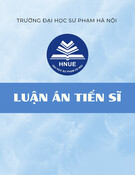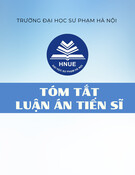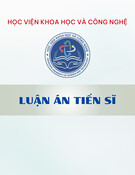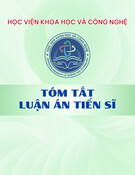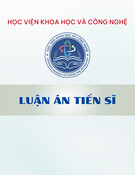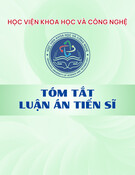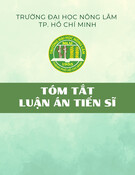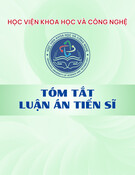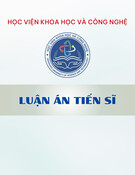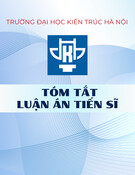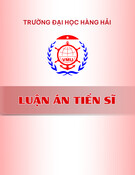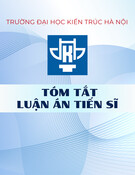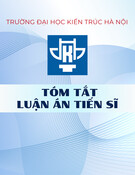
1
MINISTRY OF EDUCATION
AND TRAINING
VIETNAM ACADEMY OF
SCIENCE AND TECHNOLOGY
GRADUATE UNIVERSITY OF SCIENCE AND TECHNOLOGY
--------------------------------
TRAN THU HUONG
RESEARCH ON CHEMICAL COMPOSITIONS AND
BIOLOGICAL ACTIVITIES OF PARAMIGNYA TRIMERA
(OILV.) GUILL.) AND MORINDA LONGISSIMA Y. Z. RUAN
Speciality: Chemistry of Natural Products
Code: 9.44.01.17
SUMMARY OF DOCTORAL THESIS IN CHEMISTRY
Ha Noi, 2020

2
The thesis was completed at: Graduate University of Science and
Technology – Vietnam Academy of Science and Technology
Scientific Supervisors 1: Assoc. Prof. Nguyen Manh Cuong
Scientific Supervisors 2: Assoc. Prof. Đo Thi Thao
Reviewer 1: …
Reviewer 2: …
Reviewer 3: ….
This thesis is going to be defended at the council of doctoral thesis
examiners of Graduate University of Science and Technology, Vietnam
Academy of Science and Technology
18 Hoang Quoc Viet, Cau Giay, Hanoi,
at ..., ...., ...2020.
The thesis can be found at:
- Library of Graduate University of Science and Technology
- National Library

3
INTRODUCTION
1. The necessity of the dissertation subject
In Vietnam, seven Paramignya species have been
identified, distributed mostly in the south of the country.
Paramignya trimera (Oliv.) Guill., local name “Than duoc” or
“Xao tam phan”, is an endemic plant in South Vietnam. The stems
and roots of the plant have been used in folk medicine to treat liver
disease, especially cirrhotic ascites.
Morinda longissima Y.Z. Ruan. (Rubiaceae) is a small-to-
medium tree, contributed in mountainous area in the North
provinces of Vietnam. The stems and roots of medicinal plant
Morinda longissima has been used by Thai's ethnic people in Son
La and Lai Chau provinces for treatment of liver disorders, collitis
and oedema.
Therefore, the task of studying their chemical composition
and biological activities of Morinda longissima and Paramignya
trimera species in our country is important and urgent. From that
point, the topic “Research on chemical compositions and biological
activities of (Paramignya trimea (Oliv.) Guill. (Xao tam phan) and
(Morinda longissima Y. Z. Ruan (Nho dong) '' was chosen.
2. The objectives of the thesis
- Study on chemical composition of Paramignya trimera
and Morinda longissima species.
- Evaluation of hepatoprotective and anti-HBV activities of
extracts and pure compounds from stems and roots of Xao tam
phan (Paramignya trimera (Oliv.) Guill.) and Nho dong (Morinda
longissima Y.Z. Ruan).
3. The main contents of the thesis
- Evaluation of hepatoprotective and anti-HBV activity of
herbal extracts.
- Isolation of compounds from stems and roots of Paramignya
trimera (Oliv.) Guill. and Morinda longissima Y.Z. Ruan.
- Determination of chemical structures of isolated compounds.

4
- Evaluation of hepatoprotective and anti-HBV activity of isolated
compounds.
Outline of the thesis:
The thesis consists of 139 pages with 45 tables, 21 figures,
4 schemes of isolation and 137 references. The thesis consists of 4
chapters: Introduction (2 pages), Chapter 1: Liturature overview
(28 pages); Chapter 2: Materials and Methods (02 pages); Chapter
3: Results (10 pages), Chapter 4: Discussion (83 pages);
Conclusion (2 pages); Suggestion (1 page); Publications related to
the thesis (1 page); References (15 pages); Appendix (31 pages).
CHAPTER 1: LITERATURE OVERVIEW
This part reviews the following points:
- The chemical composition and biological activities of compounds
isolated from Paramignya plants were presented thoroughly.
- The chemical compositions and biological activities of
compounds isolated from Morinda plants were presented
thoroughly.
- An overview of biological techniques for screening
hepatoprotective and anti-HBV activity was presented in detail.
CHAPTER 2: MATERIALS AND METHODS
2.1.Plant Materials
The stems and roots of Paramingya trimera and Morinda
longissma were collected in Khanh Hoa province and in Son La
province, Vietnam, respectively. The plants were identified by the
botanist Dr. Nguyen Quoc Binh, Vietnam National Museum of
Nature, VAST. Voucher specimens (C-499 and C-547) are
deposited in the herbarium of the Institute of Natural Products
Chemistry, VAST, Hanoi, Vietnam.
2.2. Method
- Phytochemical techniques
- Chromatographic TLC analysis on precoated plates of silica gel
60 F254, separation methods including column chromatography on
silica gel, C-18 silica gel, Diaion HP-20, Sephadex LH-20 were
used to isolate natural compounds from plant extracts.

5
- Structures of isolated compounds were identified by physical,
chemical and spectroscopic methods including ESI-MS, HR-ESI-
MS, IR, UV, 1D và 2D-NMR.
- Evaluation of biological activity
The biological activities of the extracts and pure natural
compounds were evaluated including:
-In vitro anti-HBV activity on HepG2.2.15 cell line based on
HBsAg expression levels with 50% inhibitory concentration values
(IC50).
- In vivo hepatoprotective activities against paracetamol-induced
hepatotoxicity in BALB/c mice.
CHAPTER 3: EXPERIMENTAL AND RESULTS
3.1. Evaluation of hepatoprotective and anti-HBV activities of
herbal extracts
3.2. Isolation of natural compounds from Paramignya trimera
From the stems and roots of Paramignya trimera, 10
compounds, including four coumarins: ostruthin (PT-1); ninhvanin
(PT-2, new compound); 6-(6-hydroxy-3,7-dimethylocta-2,7-
dienyl)-7-hydroxycoumarin (PT-6); ninhvanin B (PT-7, new
compound); two dimeric monoterpene-linked coumarin
glycosides, paratrimerin A (PT-8, new compound); paratrimerin B
(PT-9, new compound); a new alcohol, paramitrimerol (PT-5,
new compound), a chromene: 6-(2-hydroxyethyl)-2,2-dimethyl-
2H-1-benzopyran (PT-3), an alkaloid: citrusinine-I (PT-4) and a
new limonoid, parabacunoic acid (PT-10, new compound) were
isolated.
- Spectroscopic data of isolated compounds.
3.2. Isolation of natural compounds from Morinda longissima
From the stems and roots of Morinda longissima, 22 compounds,
including twelve anthranoids: damnacanthal (ML-1); lucidin-ω-
methyl ether (ML-2); soranjidiol (ML-3); morindone -5-methyl
ether (ML-4); rubiadin (ML-5); rubiadin-3-methyl ether (ML-6);
damnacanthol (ML-7); morindone (ML-8); 1-hydroxy-2-methyl-6-
methoxy anthraquinone (ML-9); morindone-6-methyl ether (ML-

